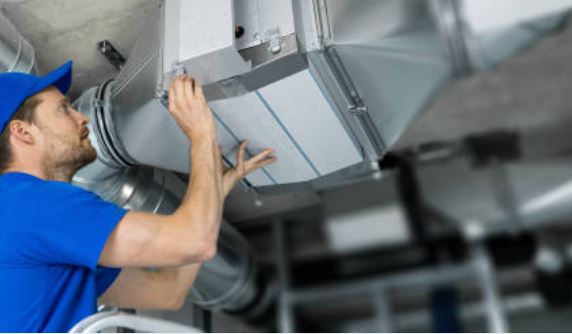What is the ideal temp for AC in summer?
This is such a common question now that summer is here with us.

call 661-888-0248
Contact us 24/7 for HVAC services!
Playing around with the thermostat settings does not make a huge difference.
Going higher on your thermostat settings may mean saving on energy bills but compromising comfort. Going lower may provide much-needed relief, but it will undoubtedly be more expensive. It is a sort of dilemma.
What is the ideal temperature for AC that will cater to your comfort while not digging deeper into your pockets?
This article reveals the thermostat setting that will keep you cool and comfortable all summer.
Let’s get straight into the details of the ideal temp for AC in summer.
What is the Ideal Temperature for AC in Summer?

According to the US Department of Energy (DOE), the suggested temperature range for your house in summer is 78 degrees Fahrenheit. This may appear a little high — or perhaps outright uncomfortable for some — but it is based on several criteria designed to minimize the energy consumption and carbon footprint related to summer AC conditioning.
The DOE also suggests adjusting your thermostat and air conditioning settings based on your availability at home and time of day. A good summertime practice is setting the thermostat to 78 degrees Fahrenheit at home and higher while traveling.
While sleeping, set the thermostat to 82 degrees Fahrenheit.
Factors to Consider When Setting your Summer Thermostat
We are all different. Therefore, not everyone will be comfortable with the 78-degree setting. We also live in different climates. Some areas are hotter, so the 78-degree setting will not be ideal for all of us.
Therefore, the following factors should determine what setting to have:
Temperature Management

Even when you set a thermostat at 72 degrees Fahrenheit, the temperature might fluctuate by up to ten degrees during the run cycle, depending on the device.
However, if you choose a higher efficiency unit (16 SEER or more), you may avoid this problem because it will manage temperature and airflow more accurately—generally within one degree. Precise adjustments can save you money on energy bills and keep you much more relaxed.
Humidity Control
During the hottest months, humidity might force you to set your AC higher than required.
By utilizing a high-efficiency unit that runs longer on less power, you can suck the air humidity from your house more efficiently. You will also filter out more airborne particles and dust.
What’s The Outside Temperature?

Think about the average outside temperature when choosing your thermostat setting. Your HVAC system will consume less energy if there is minor variation between outside and inside temperatures.
Less energy consumption means lower electricity bills on your end.
What’s the Ideal Temperature to Ensure Humidity Control in Your Home?
So, what is the summer’s best humidity level for your house? The Environmental Protection Agency (EPA) recommends keeping interior humidity levels below 60% relative humidity, preferably between 30 and 50%.
If you possess a humidifier, it may contain an in-built humidistat that monitors the humidity level in your house. If not, you can buy a hygrometer from a nearby hardware store.
Regarding humidity, the general guideline is to adjust your thermostat as high as your level of comfort permits, as long as it’s cool enough to maintain a healthy humidity level.
What’s Your Ideal Indoor Temperature for Comfort?

Set your thermostat to the suggested 78 degrees Fahrenheit to determine the perfect temperature for personal comfort. If you discover that you are either too hot or too cold, gradually increase the temperature by one degree until you’re comfortable enough.
How Frequently Do You Leave The House, and How Many Hours Do You Sleep Every Night?
While you should keep an eye on your indoor humidity level, maintaining your optimum living temperature while you’re away is no longer necessary. Furthermore, the optimum temperature of most people when they’re sleeping or awake varies.
Also, this helps you not overwork your air conditioning system. This is a great way to avoid constant heating repair, which comes due to overworked systems.
Additionally, hanging your thermostat setting to different temperatures across the day can significantly reduce your energy expenditures. You might save up to an amazing 10% on your annual electricity bills by adjusting your thermostat by 7°-10°F from its traditional setting for 8 hours per day.
The nearer your thermostat is to the outdoor temperature, the greater the savings percentage.
How to Keep an Even Graph Between Comfort and Cost
We understand that you are trying to save money on your energy bill and still escape the heat of the summer. Above, we discussed this by adjusting the temperature when you are in and out of the house. However, this step is only the beginning. You can use more tips to keep your house temperature and energy bill down, like buying programmable thermostats and seasonal AC maintenance.
Tip #1: Get Programmable Thermostats

Setting your thermostat to higher or lower temperatures might seem hectic depending on your routine and the time of day. However, setting up a pre-set schedule is simple when installing a programmable thermostat.
Once you’ve settled on a working strategy, you can “set and forget” your programmable thermostat, eliminating all the hassle. Furthermore, you can manually alter those temperature settings without influencing the rest of your program.
Another amazing benefit of having a programmable thermostat is that you can configure it to warm or cool your house before you wake up or return from a trip. The discomfort you might feel, for instance, if you stepped into a heated house and had to sit tight for it to cool down, is avoided as a result.
Tip #2: Seasonal AC Maintenance

Before the summer heat arrives, conduct a spring HVAC maintenance to verify the unit is operating correctly, refrigerant levels are adequate, and the unit’s cooling system is efficient.
Leaky air ducts, inadequate insulation, and overgrown vegetation surrounding your air conditioner can reduce performance.
Looking for a way to maintain your system? A simple search for “air conditioner maintenance near me” should match you to your local HVAC technician.
Tip #3: Invest in Energy-Efficient Air Conditioning

Even if you raise your thermostat temperature, your energy bill may not decrease if your AC malfunctions. To save energy and keep your house comfortable, you may need to replace your HVAC system.
A new Energy Star® certified system with a high Seasonal Energy Efficiency Ratio (SEER) rating can be 15% more cost effective than older, inefficient models. Newer systems, which often have 2-stage cooling and a variable-speed fan, can also increase your comfort(1).
Even on the lowest setting, this AC unit will keep you cooler more consistently. It also runs longer without the unnecessary starts and stops. It also eliminates twice as much humidity from your home.
Also, with an energy efficient system, you will most likely not need frequent emergency air conditioner service.
When it is Approx. 100 Degrees Outside, How Cool Should Your House be?

Many HVAC and AC unit technicians recommend a 20-degree Fahrenheit gap between your home’s indoor and outdoor temperatures. If the temperature outside reaches 100 degrees, turn your air conditioning down to 80 degrees Fahrenheit.
Chilled residences lose heat faster than homes in line with the outside temperature. This is because a colder room absorbs the warmer outside air much more quickly than a warmer area, making your air conditioner work harder to keep the building cool.
In contrast, the slower the inflow of warmer air from outside, the warmer the inside temperature. As a result, the closer the inside temperature is to the outdoor temperature, the less frequently your air conditioning will operate, resulting in less energy use.
Frequently Asked Questions on Ideal AC Temp for Summer

- What is a Good Temperature for AC in summer?
According to the DOE, the recommended AC temperature for summer is 78 degrees Fahrenheit. You can, however, adjust it to suit your comfort and cooling needs.
- How Can I Save on My AC Bill in Summer?
Here are some tips on how to set AC temperature in summer, while still incurring low costs.
- Checkup your AC regularly.
- Get a programmable thermostat.
- Use fans instead of air conditioning..
- What is the Ideal AC temperature for winter?
Your AC temperature in winter according to Energy.gov should be 68 degrees Fahrenheit(2). This is the setting you should put on when you are awake and at home.
Final Thoughts on the Ideal AC Temp for Summer

It is our time to call it curtains for the ideal temperature for AC in summer. By following these tips mentioned above, you should be able to wave off about 20–25% of your energy bill.
While routine maintenance procedures like cleaning the air conditioner filter and contacting a technician to optimize the AC unit are essential, temperature settings also play a significant role in air conditioning costs.
Looking for other ways to save money this summer? Give us a call for complimentary information on summer-saving tips.

call 661-888-0248
Contact us 24/7 for HVAC services!
Sources
https://www.moneycontrol.com/news/business/economy/explained-why-you-should-keep-the-ac-at-24c-4711541.html
https://www.livemint.com/Money/VOUrj7s47bJreraISIca0J/Running-your-AC-at-27C-vs-18C-can-cut-your-electricity-bil.html
